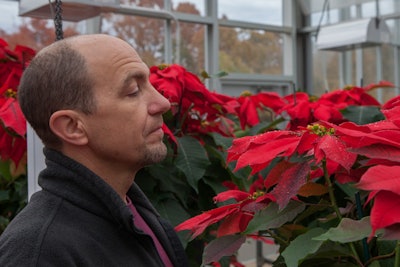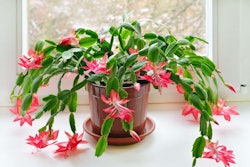 Photo: Clemson University
Photo: Clemson UniversityThe poinsettia has come a long way from its wild ancestor, but this plant hasn’t been domesticated to the point where it can’t be transplanted to the backyard after the holiday season.
“Today, the varieties pretty easily last through Christmas and January and February,” says James Faust, floriculturist and associate professor at Clemson University. “If you just have a decent light environment in the home, they’ll survive and then you can plant them outside after the danger of frost has passed, and they’ll grow all summer.”
If your client is wanting to have their potted poinsettia last until they can plant it in the spring, pass along these winter care tips.
The more light, the better. Faust says that for the poinsettia to maintain their flowers and leaves, they still need light to complete photosynthesis.
Avoid overwatering. When poinsettias are sold in pots covered with foil or plastic, these covers tend to not have drainage holes, causing water to set at the bottom of the pot. Faust advises watering with a cup or two of water a week.
Keep temperatures stable. Poinsettias aren’t too picky about temperatures but those below 40 degrees or above 80 degrees Fahrenheit should be avoided. Placing the plant near a heater or a drafty window isn’t a good idea.
Once the poinsettia has dropped its leaves, cut the stems back to 4 to 6 inches high. Wait until nighttime temperatures are consistently above 55 degrees Fahrenheit before transplanting it. The location where the plant is installed should have good drainage and receive full sun.
When the plant has become established, you or your client can begin fertilizing and watering it on a regular basis.
To prevent it from becoming tall and scraggly, poinsettias growing outdoors require regular pruning around every two months. Pinching the tips of new growth will create a much bushier plant with smaller flower bracts while thinning the branches without pinching will produce larger flower bracts.
If your client wants their bracts to turn a luscious red during the next holiday season, they need their poinsettia to be planted in a spot that stays completely dark for 12 to 14 hours every night starting in October. Even streetlights can affect flowering when the buds are forming.
If this isn’t possible, they can always cover the plant with a light-blocking material at night. Because poinsettias are very sensitive to frost and tend to only thrive in hardiness zones from nine to 11, it might be best to keep the poinsettia growing in a container so it is easier to move it back indoors during the winter months.
“There are a few parts of the country where poinsettias are still used as landscape plants,” Faust says. “In South Florida and South Texas and Southern California, you’ll see poinsettias in the landscape, and usually they’re older varieties from the early 1900s that were used at cut flower varieties that you’ll see in the landscape. They’ll get up about 8 to 12 feet tall and they’re big shrubs that will flower in November, December, and they’re quite beautiful but you have to be someplace where it doesn’t freeze.”










